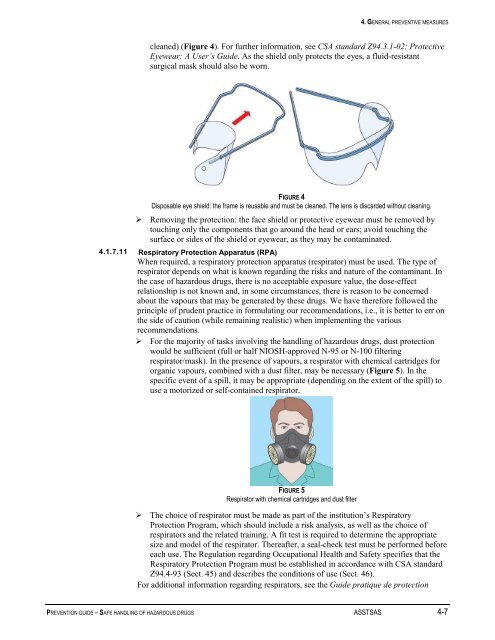Prevention Guide - Safe Handling of Hazardous Drugs - Irsst
Prevention Guide - Safe Handling of Hazardous Drugs - Irsst
Prevention Guide - Safe Handling of Hazardous Drugs - Irsst
You also want an ePaper? Increase the reach of your titles
YUMPU automatically turns print PDFs into web optimized ePapers that Google loves.
4. GENERAL PREVENTIVE MEASURES<br />
cleaned) (Figure 4). For further information, see CSA standard Z94.3.1-02: Protective<br />
Eyewear: A User’s <strong>Guide</strong>. As the shield only protects the eyes, a fluid-resistant<br />
surgical mask should also be worn.<br />
FIGURE 4<br />
Disposable eye shield: the frame is reusable and must be cleaned. The lens is discarded without cleaning.<br />
‣ Removing the protection: the face shield or protective eyewear must be removed by<br />
touching only the components that go around the head or ears; avoid touching the<br />
surface or sides <strong>of</strong> the shield or eyewear, as they may be contaminated.<br />
4.1.7.11 Respiratory Protection Apparatus (RPA)<br />
When required, a respiratory protection apparatus (respirator) must be used. The type <strong>of</strong><br />
respirator depends on what is known regarding the risks and nature <strong>of</strong> the contaminant. In<br />
the case <strong>of</strong> hazardous drugs, there is no acceptable exposure value, the dose-effect<br />
relationship is not known and, in some circumstances, there is reason to be concerned<br />
about the vapours that may be generated by these drugs. We have therefore followed the<br />
principle <strong>of</strong> prudent practice in formulating our recommendations, i.e., it is better to err on<br />
the side <strong>of</strong> caution (while remaining realistic) when implementing the various<br />
recommendations.<br />
‣ For the majority <strong>of</strong> tasks involving the handling <strong>of</strong> hazardous drugs, dust protection<br />
would be sufficient (full or half NIOSH-approved N-95 or N-100 filtering<br />
respirator/mask). In the presence <strong>of</strong> vapours, a respirator with chemical cartridges for<br />
organic vapours, combined with a dust filter, may be necessary (Figure 5). In the<br />
specific event <strong>of</strong> a spill, it may be appropriate (depending on the extent <strong>of</strong> the spill) to<br />
use a motorized or self-contained respirator.<br />
FIGURE 5<br />
Respirator with chemical cartridges and dust filter<br />
‣ The choice <strong>of</strong> respirator must be made as part <strong>of</strong> the institution’s Respiratory<br />
Protection Program, which should include a risk analysis, as well as the choice <strong>of</strong><br />
respirators and the related training. A fit test is required to determine the appropriate<br />
size and model <strong>of</strong> the respirator. Thereafter, a seal-check test must be performed before<br />
each use. The Regulation regarding Occupational Health and <strong>Safe</strong>ty specifies that the<br />
Respiratory Protection Program must be established in accordance with CSA standard<br />
Z94.4-93 (Sect. 45) and describes the conditions <strong>of</strong> use (Sect. 46).<br />
For additional information regarding respirators, see the <strong>Guide</strong> pratique de protection<br />
PREVENTION GUIDE – SAFE HANDLING OF HAZARDOUS DRUGS ASSTSAS 4-7

















